‘Behemoth’ is a word which springs to mind or, perhaps more nautically, ‘leviathan’.
- Very spacious
- Large cabin for sleeping
- Excellent on land agility
- Efficient hull and foil assist
- Wonderfully stable
New Zealand’s marine industry often delivers great innovation. Some ideas are radical, others an evolution of an earlier concept. Like the Stryda 600C. Most of her design aspects are well-proven, but there’s a fresh approach that works on every level.
The Stryda 600C features four-wheel drive technology that gives the boat its amphibious capability. This differs from other amphibians on the market – the double front-wheel provides more lateral stability and improved grip.
And the design incurs only a slight overhead in terms of space required for the front-drive mechanism. The powerful 40hp petrol engine provides impressive power for the hydraulic drive and sees a road speed of 9km/h.

The engine’s tucked neatly into a purpose-built enclosure in the transom, with a fan-cooled system providing unlimited run-time without risk of overheating. An anti-stall system maintains constant wheel RPM when transitioning between land and sea.
Sealed hydraulics, engineered in marine-grade stainless steel, include a traction control system to eliminate slip on challenging terrain. The cat has advanced PLC controllers and smart brakes (with a standby park function) to ensure the boat won’t roll away if left unattended.
The catamaran hull comes into its own in terms of space, both inside the cabin/cockpit and also for locating the drive mechanism. The front-wheel folds up perfectly between the asymmetrical hulls in the bow and is clear of water while underway.
With the wheels mounted in the hull there’s a tight turning radius, enabling the craft to be manoeuvred around confined spaces. The positioning of the front-wheel also mitigates the ‘cat sneeze’ – a spurt of spray out front between the hulls that some catamarans suffer from when coming down a wave.
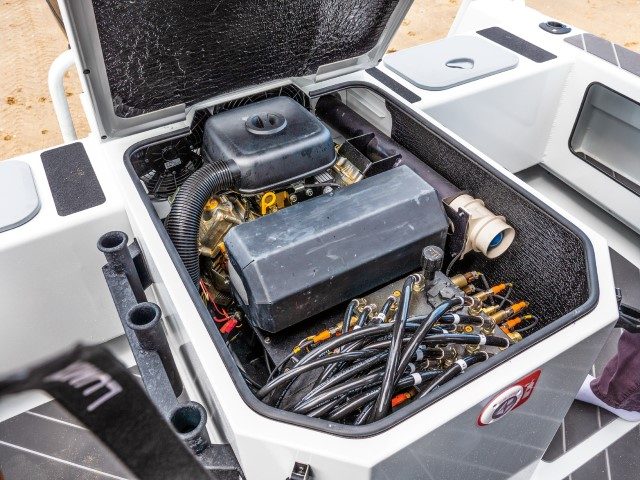
The wheels at the rear retract up neatly against the transom, and a clever extension to the mechanism provides a set of easy-climb steps up the boat’s port side. This means a separate boarding ladder is not needed and since these are offset (like stairs), they’re actually easier to use than a ladder. Once on the boarding platform stepping over the transom into the cockpit is easy.
Before climbing on board though, it’s worth taking a look at the latest-generation Suzuki DF350A four-stroke outboard. In particular, the pair of counter-rotating stainless propellers, more commonly seen on upper-end sternlegs, and the relatively small gearcase for such a massive power output.
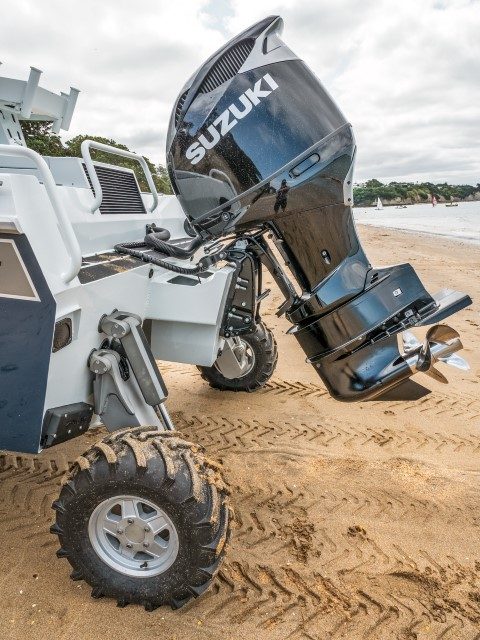
Suzuki says using two props spreads the torque and allows the gear diameter to be reduced. Counter-rotation also reduces the tendency to ‘prop walk’, making the boat easier to steer both at speed and when manoeuvring. This new model Suzuki’s two-tone colour scheme is particularly striking, although it’s also available with a white cowling.
The boat’s interior is either painted or anodised, with no raw aluminium anywhere. The deck’s covered in Ultralon that’s soft on the feet, stylish and hardwearing. There are numerous rod-holders and storage compartments under the broad gunwales, and these have further Ultralon foam pads to form a comfortable seat.
With the craft being a genuine 6m hull there is a surprising amount of cockpit space, another benefit of the catamaran design.
The rear edge of the hardtop has a custom, anodised rocket-launcher that unclips and folds down so the boat fits into the owner’s garage. The two luxuriously-padded seats are both mounted on Shark suspension mounts (another New Zealand innovation!) for a very comfortable, smooth ride.
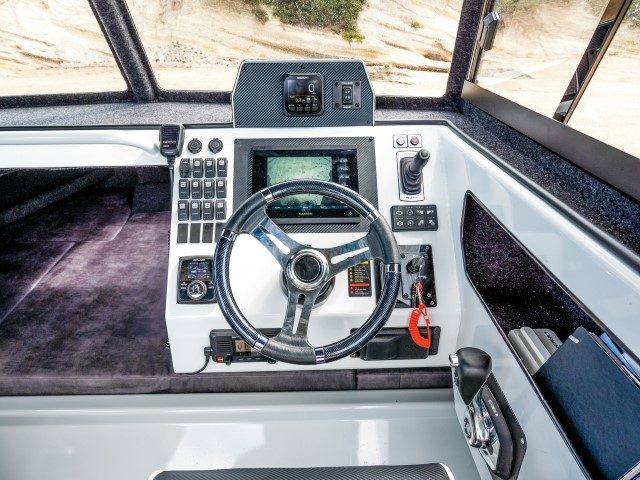
This system is commonly used on boats that have to travel fast through all conditions (such as rescue vessels) and the suspension mounts absorb the impact when going through waves and chop. It allows higher speeds in uncomfortable seas and certainly helps relieve the strain on the body.
The helm’s well-equipped with a Garmin multi-function display, a Suzuki marine digital gauge and controls for the Zipwake automatic trim tabs. To the right of the hydraulic steering are the instruments for the amphibious system, with controls to start the hydraulic power unit, engage forward and reverse drive – and lift or lower the wheel assembly.
A Suzuki electronic throttle to the right of the helm provides drive-by-wire control for the naturally-aspirated 4.39-litre V6 outboard.
The forward cabin shows why many people love cats – it has a massive, full length forward berth. Although the hardtop’s open at the back, it could easily be used for the occasional overnight or extended trip. The 6m hull and has more interior space than most conventional hulls, even those with a greater overall length.
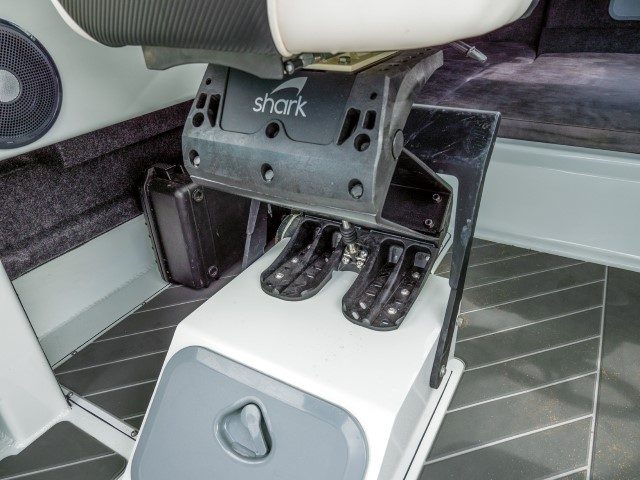
Hardtop windows are tinted to reduce glare, and a Rockna anchor sits in the stainless fairlead up front. Two downward-facing white lights in the bow are a nice feature not seen on conventional boats. They’re used to light up the beach when driving at night. A hatch in the forward cabin provides access to the bow and anchor area if required.
Play time
Stepping on board a boat without having to worry about wet feet is something I could get used to. We started the hydraulic power unit, which has quite a different sound to that of a normal outboard. Steering is through the same helm, though, so it’s just a case of engaging forward drive and driving into the water.
With the boat floating we started the outboard, raised the amphibious wheels (which auto-centre between the front hulls as they come up) and then turned the hydraulic power unit off.
Performance in the water revealed another of Stryda’s innovations: a hydrofoil blade between the hulls that provides additional lift and helps to offset the extra weight of the amphibious technology.
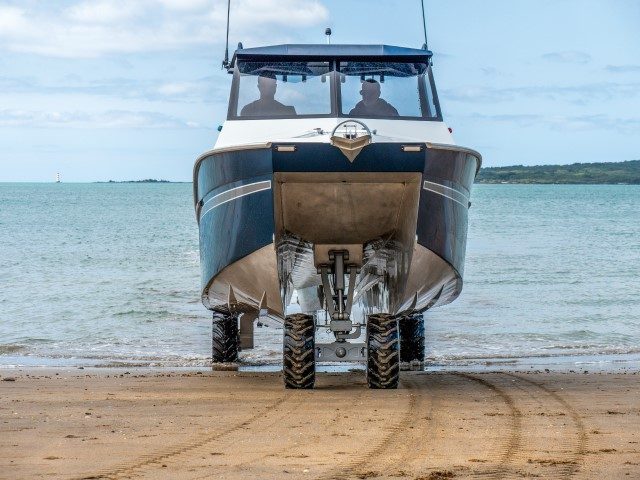
The foil also combines with those asymmetrical hulls to provide handling that is more akin to a monohull than the outward-heeling action common to catamarans. The boat heels inwards in a conventional manner through the turns, but not quite as much as would a monohull. Despite the extra weight of the amphibious technology the boat rides well with predictable handling.
The Zipwake automatic trim tab system is great – it takes all the guesswork out of trimming the boat to cater for different loads and conditions. When combined with the stability that comes from a catamaran, she’s beautifully stable at rest and also at speed.
I loved the power from those 350 horses, although to be fair she’d probably perform well even with a smaller powerplant. The hull’s rated for between 200 and 350hp – this Suzuki is right at the upper end.
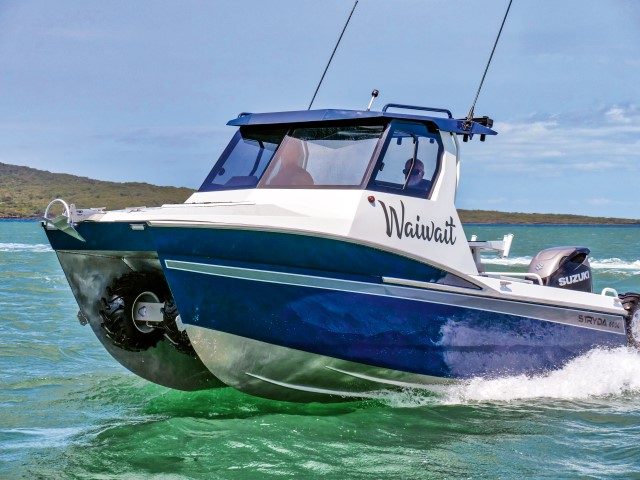
With the half-metre chop we didn’t opt for WOT, but Stryda’s Warren Farr says she gets close to 40 knots. I can well believe it. Acceleration is also fantastic, and despite the hull weight she leaps out the hole.
Coming back into the beach is a reverse of the launching procedure. We drove slowly towards the beach, started the hydraulic power unit and lowered the wheel assembly just before we got there. Once we felt the wheels start to bite the forward drive was engaged. The outboard was given a last tweak to ensure the wheels had a good grip, and then turned off.
We didn’t need to tilt the engine as the ground clearance is more than enough it to drive with it fully down. When the wheels are engaged a forward camera, mounted under the bow, is turned on to show exactly where the front-wheel is going.
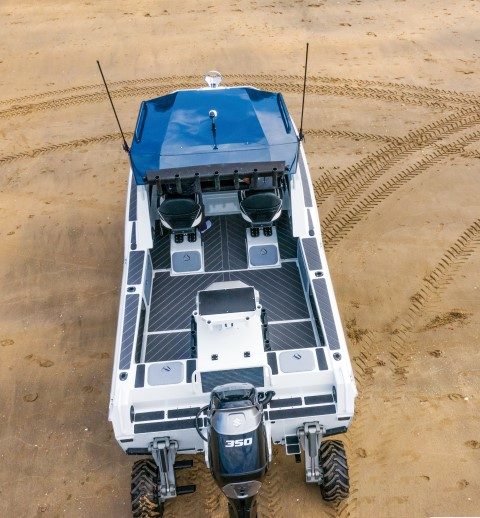
At night those front lights come into play, to light up the beach in front of the wheels. The all-wheel-drive had no problem negotiating a ‘step’ in the beach. The hydraulic drive has both forward and reverse, plus brakes, and manoeuvres easily from any terrain.
The Stryda 600C is a excellent boat, quite different from other amphibious options currently on the market. The catamaran hull has tremendous benefits, and the build quality is superb.
This is a boat that will turn heads everywhere, for all the right reasons.
‘Behemoth’ is a word which springs to mind or, perhaps more nautically, ‘leviathan’.
White Pointer has earned the respect of discerning customers in New Zealand and Australia, attracting a loyal and ever growing following for its high-quality, rugged and totally dependable aluminium trailer boats.
The hardtop SP635 shares the same underpinnings as the popular SF 635 which was a completely new model back in 2020.
The pride and joy of a multi-generational family, Bliss resides on a pier that’s home to a couple of other Elite motor launches – Sandspit Marina is a hot-spot for the Bill Upfold-designed vessels, with several calling this small marina home.